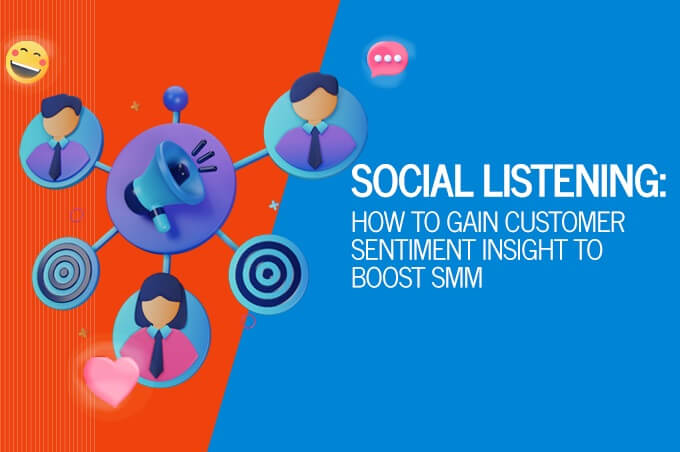Social Listening: How to Gain Customer Sentiment Insight to Boost SMM
 June 17, 2025 | By Ilfusion Team
June 17, 2025 | By Ilfusion Team
To succeed in social media marketing (SMM), brands need more than just likes and shares—you need to understand how your audience truly feels. Knowing your audience’s sentiment gives you the context needed to build real, lasting connections.
Social listening is a powerful tool that helps businesses track, interpret, and act on customer sentiment in real time. These insights allow you to shape strategies that resonate more deeply and reflect your audience’s needs and expectations.
What Is Social Listening?
Social listening means keeping an ear to online conversations so you can understand what people are saying about your brand, industry, or competitors.
It goes beyond tracking mentions. It’s about interpreting the meaning behind them to make smarter business decisions.
While most social media platforms have their own built-in tools for monitoring conversations, there are also third-party tools that can provide more granular data. Here are some popular tools for social listening:
- Sprout Social: Comprehensive reporting and sentiment analysis
- Hootsuite Insights: Real-time social monitoring with keyword filtering
- Brandwatch: Advanced AI-powered sentiment tracking
What Is Customer Sentiment?
Customer sentiment captures how people feel when they mention your brand: positive, negative, neutral, or mixed. It helps identify how people perceive your brand and why.
Here’s what each customer sentiment means:
- Positive sentiment: Praise, compliments, or excitement about your products or services. Positive sentiment helps you identify what’s working well and can be amplified in your marketing.
- Negative sentiment: Complaints, criticism, or frustration shared publicly. Negative sentiment reveals pain points or dissatisfaction. While it may seem discouraging, this type of feedback is valuable for improving your offerings and customer support.
- Neutral sentiment: Informational or factual statements without emotional tone. These posts may mention your brand, but don’t convey a clear opinion. However, it still provides useful context, especially for tracking brand mentions.
- Mixed sentiment: Posts that contain both positive and negative feedback. These comments may highlight good experiences alongside areas that need improvement, offering a more balanced perspective.
5 Social Listening Tips to Gain Customer Sentiment Insight
To get the most out of social listening, approach it with intention and clarity. Here are some tips to help you get started:
1. Set Clear Listening Goals
Before diving in, determine what you want to learn. Are you tracking brand mentions, campaign reactions, or competitor comparisons?
Defining your objectives upfront helps you focus your efforts and avoid information overload. With clear goals, you can determine what data to collect, how to interpret it, and how it will support your broader marketing strategy.
Whether it’s improving engagement, refining messaging, or identifying customer pain points, knowing your “why” ensures you’re listening with purpose.
2. Monitor the Right Keywords and Phrases
The quality of your social listening depends on the keywords you track. Include your brand name, product names, slogans, and even common misspellings.
Hashtags, industry terms, and competitor names are equally important to broaden your listening scope. This allows you to capture a more accurate and complete picture of online conversations that matter to your business.
Keep your keyword list updated as trends evolve and as your campaigns shift. Listening to the right terms ensures you’re not just collecting data; you’re capturing the conversations that actually impact your brand’s visibility and reputation.
3. Analyze Sentiment Over Time
Looking at sentiment in the moment is helpful, but long-term analysis reveals deeper patterns.
Track how audience sentiment changes before, during, and after key events like product launches, campaigns, or crises.
This historical view helps you see what resonates with your audience and what doesn’t, providing a feedback loop for ongoing improvement. It also allows you to identify red flags early and act before negative sentiment spreads.
4. Segment by Platform and Audience
Different social platforms attract different types of users, and sentiment can vary widely between them. A lighthearted campaign may work well on Instagram but fall flat on LinkedIn.
By segmenting your listening by channel, demographics, and geographic regions, you gain more targeted insights that reflect each audience’s unique behavior and expectations.
This segmentation allows you to create tailored strategies for each platform rather than applying a one-size-fits-all approach. It also helps uncover which audiences are most engaged or concerned, enabling you to prioritize outreach where it matters most.
5. Respond with Authenticity
Social listening isn’t just about observing; it’s about taking action in a way that feels genuine.
When you respond, do it with empathy and transparency. Acknowledge concerns, celebrate positive feedback, and don’t rely on scripted replies. Customers want to feel heard, not managed.
By showing your brand cares and adapts based on feedback, you build trust and emotional connection. Over time, these authentic interactions strengthen customer loyalty and reinforce your brand’s credibility in the public eye.
Take Your Social Media Marketing to the Next Level
Understanding your audience’s true feelings helps you move from reactive to proactive in your SMM efforts. With the right tools and strategy, social listening becomes your competitive advantage.
Looking to sharpen your strategy? Ilfusion Creative offers expert-led social media marketing services designed to elevate engagement and results.
Reach out today at 888-420-5115 or send us an email at cr******@******on.com to learn how we can help you connect with your audience on a deeper level.

